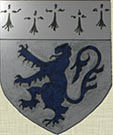
Barn at Home Farm, Skelton. Built 1642 Restored 1831
[W III presumably refers to King William IV 1830-1837
and William of Orange 1697-1702 was discounted and seen in "1831" as the Dutch Consort
of Mary]
|
1642
CIVIL WAR. A piece of local folk-lore has it that Cromwell passed close to Skelton, but missed the Castle hidden in the woods.
The locals, however, were heard and given a good beating on Flowston.
A small skirmish took place somewhere between Skelton and Guisborough between Royalists under the command of Colonel Slingsby and Parliamentarians under Sir Hugh Cholmley and Sir Matthew
Boynton.
Slingsby was taken prisoner and some of his men killed.
The influential battle of Marston Moor took place between Knaresborough and York.
A Slingsby held Knaresborough Castle against a long seige and was the last person to be executed for plotting after the Civil War.
Another piece of folk lore from this period claims that Charlie's Hill at nearby Stanghow is so called because Charles I used it as an observation to watch fighting at Kilton and Skelton.
|



